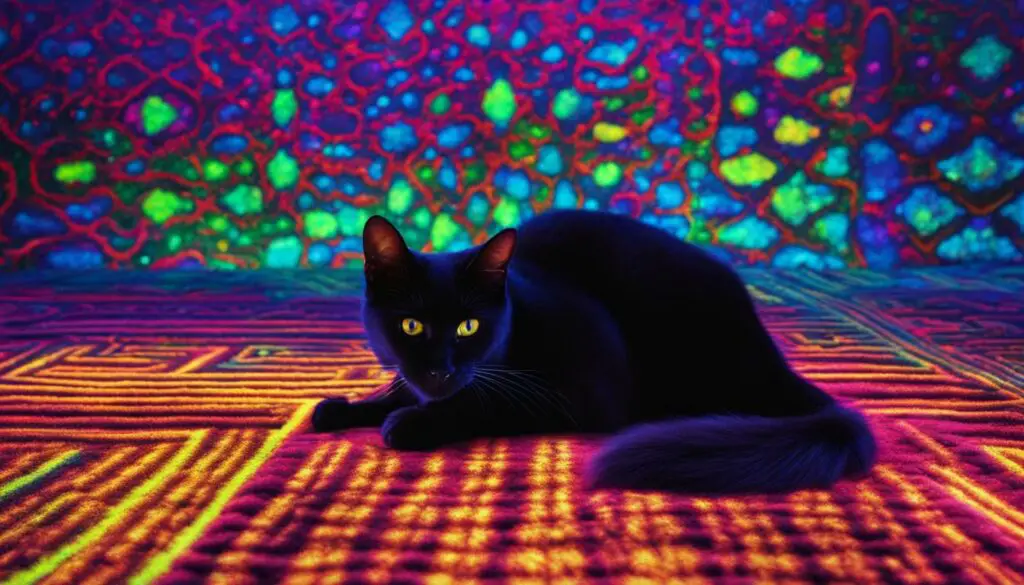Have you ever wondered if a black light can help you detect cat urine stains that are not visible to the naked eye? Well, you’re in luck! In this article, I will explain how black lights, specifically UV black lights, can be an effective tool for locating hidden cat urine stains in your home.
Cat urine stains can be a real nuisance, especially if they go undetected and untreated. They not only leave behind an unpleasant odor but can also harbor bacteria and other harmful substances. That’s where a black light comes in handy. By shining a UV black light on the suspected area, you can make the invisible stains glow, making them easier to identify and clean.
However, there are a few factors to consider to ensure effective detection. Operating the black light in a dark room, using fresh batteries for optimal brightness, and conducting a thorough search of the area are essential steps to maximize the black light’s effectiveness.
Key Takeaways:
- A black light can be used to detect cat urine stains that are not visible to the naked eye.
- UV black lights shine wavelengths that cause urine proteins and phosphorus to glow, making the stains easier to identify.
- Operating the black light in a dark room and using fresh batteries are crucial for effective detection.
- A thorough search of the area is necessary to locate all hidden cat urine stains.
- Cleaning cat urine stains promptly is important to eliminate odor, prevent re-soiling, and maintain a healthy environment.
How to Use a Black Light to Find Cat Urine
Using a black light to find cat urine stains can be a useful technique for pet owners. By following a proper procedure, you can effectively detect the presence of cat urine in your home. Here are the steps to using a black light for this purpose:
- Prepare the room: Make sure the room is completely dark by closing curtains and turning off all lights. This will enhance the visibility of the urine stains under the black light.
- Choose the right black light: Use a UV black light with a wavelength between 365-385 nm. This wavelength range is specifically designed for detecting urine stains.
- Sweep the room: Start near the suspected area and move the black light outward, sweeping the room. Look for any glowing yellow or neon green spots, as these indicate the presence of cat urine stains.
- Mark the stains: Once you identify a urine stain, mark the edges of the stain with a chalk or tape for reference when cleaning it later.
By following these steps, you can effectively use a black light to locate cat urine stains in your home. It is important to note that the visibility of the stains may vary depending on factors such as the age of the stains, the type of surface, and the cleanliness of the room. Regular use of a black light can help you stay on top of any urine accidents and maintain a clean environment for both you and your cat.
“Using a black light can be an effective technique for detecting hidden cat urine stains. By following a proper procedure, you can locate the stains and take the necessary steps to clean them.”
Table: Summary of Steps to Use a Black Light for Finding Cat Urine
| Steps | Description |
|---|---|
| 1 | Prepare the room by making it completely dark. |
| 2 | Use a UV black light with a wavelength between 365-385 nm. |
| 3 | Sweep the room with the black light, starting near the suspected area and moving outward. |
| 4 | Look for glowing yellow or neon green spots that indicate the presence of cat urine stains. |
| 5 | Mark the edges of the stains for reference when cleaning. |
Using a black light to find cat urine stains can be a helpful tool in maintaining a clean and odor-free home. It allows you to identify hidden stains that may otherwise go unnoticed, ensuring that you can take appropriate measures to clean and eliminate them. Regularly checking for urine stains using a black light can help you address any issues promptly and create a healthier living environment for both you and your cat.
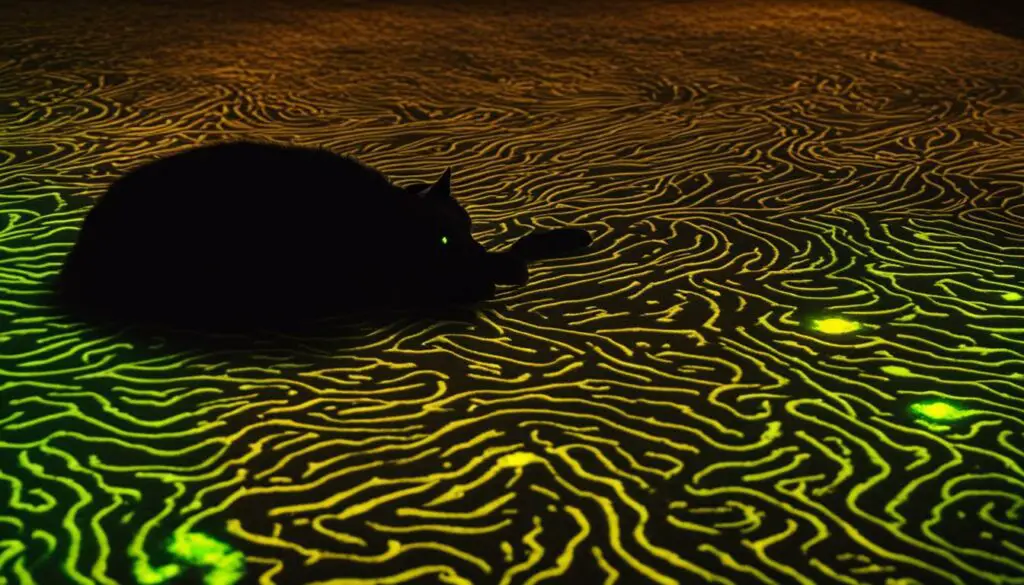
Factors Affecting Black Light Detection of Cat Urine
Using a black light to detect cat urine stains can be a useful tool in maintaining a clean and odor-free home. However, there are several factors that can affect its effectiveness in detecting these stains.
Dark Room:
In order for the black light to work properly, it is essential to operate it in a completely dark room. This enhances the visibility of the urine stains, making them easier to identify. Close the curtains, turn off all lights, and ensure that there is no external light source that could interfere with the black light detection.
Wavelength Range:
Another important factor is using a UV black light with the appropriate wavelength range. The ideal range for detecting cat urine stains is between 365-385 nm. This specific wavelength causes the proteins and phosphorus in the urine to fluoresce and glow, making the stains more visible under the black light.
Surface and Dryness:
The surface on which the cat urine is deposited can also affect the visibility of the stains under the black light. Absorbent surfaces like carpet and upholstery tend to show a stronger glow compared to hard surfaces like tile or hardwood floors. Additionally, the urine stains will only fluoresce if the surface is dry. If the area is wet or has been recently cleaned, the black light detection may not be as effective.
Color and Pattern:
The color and pattern of the surface can also impact the visibility of the urine stains. Dark-colored surfaces may absorb more light, leading to a weaker glow, while lighter-colored surfaces may reflect more light, enhancing the visibility of the stains. Similarly, patterns or textures on the surface can make it more difficult to detect the stains, as the black light may not reach all areas evenly.
| Factors | Impact on Detection |
|---|---|
| Dark Room | Enhances visibility of urine stains |
| Wavelength Range | 365-385 nm for optimal detection |
| Surface and Dryness | Absorbent surfaces show stronger glow; dryness is essential for fluorescence |
| Color and Pattern | Dark surfaces may weaken glow; patterns can make detection challenging |
By considering these factors and ensuring the proper conditions for black light detection, you can increase the effectiveness of locating and cleaning cat urine stains, maintaining a fresh and odor-free environment for both you and your furry companion.
How to Clean Cat Urine Stains
Once cat urine stains have been detected using a black light, it is important to clean them properly to remove the odor and prevent re-soiling. The following steps will guide you through the process of effectively cleaning cat urine stains:
- Start by soaking up any excess urine using rags or paper towels. Gently press down on the stained area to absorb as much urine as possible.
- For fresh stains, blot the area with a mixture of warm water and dish soap to loosen the crystals. Avoid scrubbing, as this can spread the stain further.
- For older or dried stains, use a mixture of white vinegar and water in a 1:2 ratio. Apply the solution to the stained area and let it sit for 5-10 minutes to break down the odor-causing compounds.
- After applying the cleaning solution, use a clean cloth or sponge to blot the area and absorb the moisture. Repeat this step as needed until the stain and odor are no longer present.
- Ensure that the cleaning solution reaches the fibers of the carpet or upholstery. This may require gently agitating the area with a soft brush or cloth.
- Finally, thoroughly rinse the cleaned area with water and blot it dry. For larger or heavily soiled areas, it may be necessary to use a wet vacuum or seek professional cleaning services.
Remember to test any cleaning solutions on a small, inconspicuous area of the carpet or upholstery before applying them to the entire stain. This will help ensure that the solution does not cause any discoloration or damage to the material.
“Proper cleaning of cat urine stains is crucial to eliminate the odor and prevent re-soiling. By following these steps and using the appropriate cleaning solutions, you can effectively remove cat urine stains and maintain a clean and fresh living environment.”

| Cleaning Solution | Ingredients | Instructions |
|---|---|---|
| Warm Water and Dish Soap | – Warm water – Dish soap |
1. Mix warm water and dish soap. 2. Blot the stained area with the mixture. 3. Repeat as needed. 4. Rinse with water and blot dry. |
| Vinegar and Water Solution | – White vinegar – Water |
1. Mix white vinegar and water in a 1:2 ratio. 2. Apply the solution to the stained area. 3. Let it sit for 5-10 minutes. 4. Blot the area with a clean cloth. 5. Rinse with water and blot dry. |
Other Uses for Black Lights
Black lights have a variety of uses beyond detecting cat urine stains. They are commonly employed for stain detection in general, as well as for identifying substances that fluoresce under UV light. Some examples include:
- Identifying stains from bodily fluids such as saliva, blood, or urine.
- Detecting stains caused by cleaning products, such as bleach or certain detergents.
- Revealing the presence of certain types of bacteria that produce fluorescent compounds.
In addition to stain detection, black lights are also utilized for various entertainment purposes. They are commonly seen in venues that feature glow-in-the-dark or neon-themed events. Black lights can be used to create captivating neon and fluorescent artwork or enhance the glow of objects and materials that are UV reactive.
Table: Different Uses for Black Lights
| Application | Description |
|---|---|
| Stain detection | Black lights can help identify stains from bodily fluids, cleaning products, and certain types of bacteria. |
| Glow-in-the-dark events | Black lights are commonly used in entertainment venues for creating neon and fluorescent effects. |
| Artistic applications | Black lights can be utilized to create captivating neon and fluorescent artwork. |
| Photography effects | Black lights are utilized in photography to enhance the glow of UV reactive objects. |
Whether it’s for practical use or creative endeavors, black lights offer a range of applications beyond their primary function of detecting cat urine stains. Their ability to reveal fluorescent compounds makes them a valuable tool in various industries and settings.
Tips for Choosing the Right Black Light
When it comes to choosing the right black light for detecting cat urine stains, there are a few important factors to consider. The right black light will help you effectively locate and identify urine stains in your home, ensuring thorough cleaning and odor removal.
First and foremost, look for a UV flashlight or handheld LED light with a wavelength between 365-385 nm. This specific range of wavelengths is most effective for detecting urine stains and ensuring optimal visibility. Using a black light with the right wavelength will maximize your chances of finding even the faintest traces of cat urine.
Furthermore, consider the number of bulbs or LEDs in the light. More bulbs generally provide a brighter and more powerful beam, making it easier to spot urine stains. Additionally, check the battery life of the black light. Some lights are rechargeable, while others require regular battery replacement. Choose a black light with a battery life that suits your needs, especially if you’ll be using it frequently.
Finally, it’s always a good idea to read reviews and compare different models before making your final decision. This can give you valuable insights into the performance, durability, and overall quality of the black light. By taking these tips into consideration, you can choose a black light that meets your specific requirements and helps you effectively detect and clean cat urine stains.
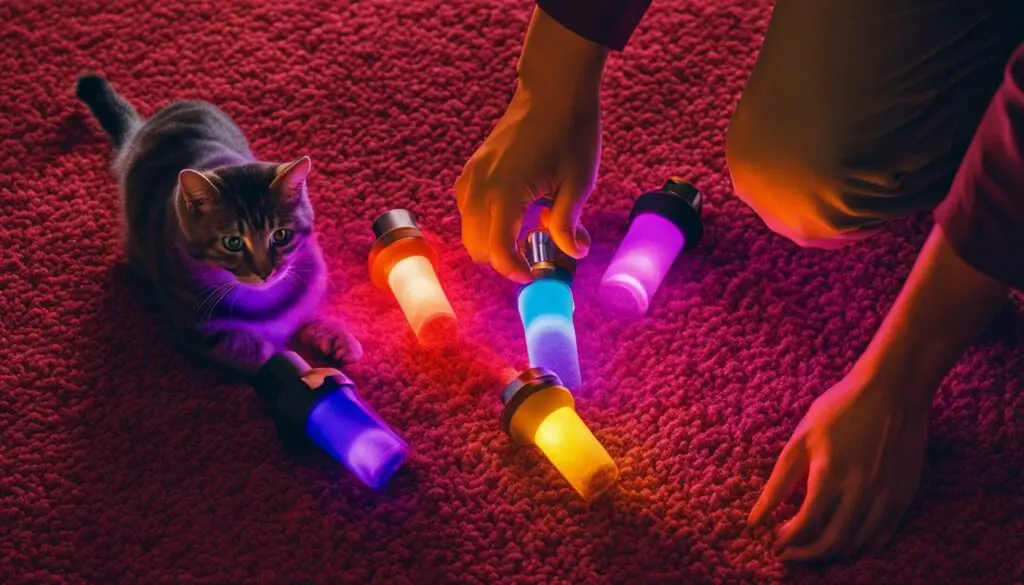
Alternative Methods for Detecting Cat Urine
While UV black lights are the most effective method for detecting cat urine stains, there are alternative methods that can be used. Some pet owners have found success using DIY black lights made from common household materials like highlighter markers or blue LED flashlights. These homemade black lights may not be as powerful or accurate as commercial UV black lights, but they can still aid in identifying urine stains to some extent. It is important to note that DIY black lights may not provide the same level of safety and reliability as professionally designed black lights.
In addition to DIY black lights, there are also other methods for detecting cat urine stains without the use of specialized equipment. One method is to use your sense of smell. Cat urine has a distinctive odor, so sniffing the suspected area can often help in identifying urine stains. Another method is to use a moisture meter, which can detect high levels of moisture that may be indicative of urine. Lastly, you can use a fluorescent dye, which can be applied to the suspected area and then illuminated with a regular flashlight. The dye will fluoresce under the light, making the urine stains visible.
While these alternative methods can be useful in detecting cat urine stains, they may not be as reliable or efficient as UV black lights. It is important to consider the limitations of these methods and use them in conjunction with other techniques, such as visual inspection and cleaning procedures, to effectively locate and remove cat urine stains.
DIY Black Light for Cat Urine Detection:
If you’re interested in trying a DIY black light method for detecting cat urine stains, here’s a simple guide:
- Take a highlighter marker (preferably yellow or green) and remove the ink cartridge.
- Break the ink cartridge open and extract the ink-soaked felt strip.
- Place the ink-soaked felt strip on a clean white surface, such as a plate or paper towel.
- Turn off the lights in the room and close the curtains to create a dark environment.
- Hold the homemade black light near the suspected area and observe any fluorescence or glowing.
Remember, DIY black lights may not be as effective as commercial UV black lights, but they can still provide some assistance in detecting cat urine stains. It is important to exercise caution and follow proper safety guidelines when using any type of black light or cleaning agent.
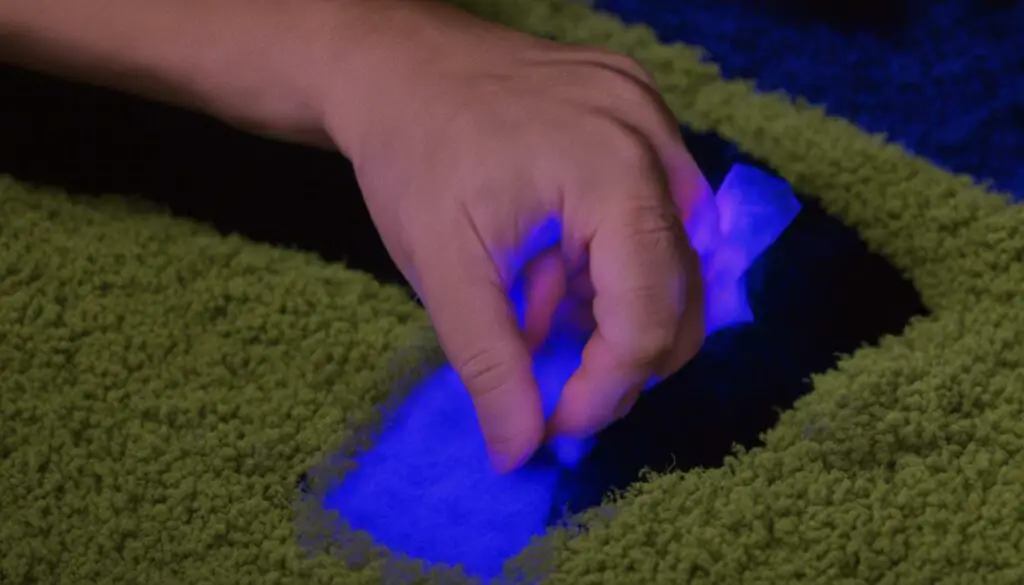
Preventing Cats from Urinating Outside the Litter Box
Cats urinating outside the litter box can be a frustrating problem for pet owners. However, with the right approach, it is possible to prevent these accidents and ensure that your cat consistently uses the litter box. Here are some tips to help you stop cats from urinating outside the litter box:
- Provide a clean and comfortable litter box: Cats are naturally clean animals and may avoid a dirty or unpleasant litter box. Make sure to scoop the litter box regularly and change the litter at least once a week to keep it fresh and inviting.
- Ensure proper hygiene: Cats can be sensitive to strong odors, so avoid using heavily scented litter or cleaning products. Stick to unscented options to prevent your cat from being deterred by the smell.
- Offer multiple litter box options: If you have multiple cats, make sure to provide enough litter boxes for each cat. Having multiple options can reduce competition and territorial issues, making it more likely that each cat will use the litter box.
- Address environmental stressors: Cats may urinate outside the litter box due to stress or anxiety. Identify any potential triggers, such as changes in routine, new pets, or loud noises, and try to minimize their impact. Creating a calm and secure environment can help prevent accidents.
It’s important to remember that cats may also urinate outside the litter box due to medical issues. If you’ve tried these prevention strategies and the problem persists, it’s advisable to consult with a veterinarian to rule out any underlying health problems.
By taking proactive measures and addressing the root causes of inappropriate urination, you can successfully prevent cats from urinating outside the litter box and create a clean and harmonious living environment for you and your feline companion.
Health Risks of Cat Urine
Exposure to cat urine poses certain health risks that cat owners should be aware of. Cat urine can contain bacteria, viruses, and other microorganisms that can be harmful to human health. Inhaling the odor of cat urine can cause respiratory issues, allergic reactions, and even infections, especially for individuals with compromised immune systems or respiratory conditions.
Direct contact with cat urine can also lead to skin irritations and infections. It is important to take proper precautions when cleaning cat urine stains, such as wearing gloves and avoiding direct contact with the urine. Additionally, it is crucial to clean and disinfect the affected areas thoroughly to eliminate any potential health hazards.
If you experience any symptoms such as persistent coughing, sneezing, skin rashes, or respiratory difficulties after being exposed to cat urine, it is recommended to seek medical attention. A healthcare professional can assess the situation and provide appropriate guidance and treatment if necessary.
| Health Risks | Precautions |
|---|---|
| Inhalation of bacteria and viruses in cat urine | Wear a mask or use proper ventilation when cleaning cat urine stains. Consult a healthcare professional if symptoms persist. |
| Skin irritations and infections | Wear gloves when handling cat urine and thoroughly wash and disinfect any areas that come into contact with the urine. |
| Respiratory issues | Avoid prolonged exposure to cat urine odor, especially for individuals with respiratory conditions or compromised immune systems. |
Proper Disposal of Cat Urine Cleaning Materials
When it comes to cleaning cat urine stains, proper disposal of the cleaning materials is crucial to prevent contamination and the spread of odor and bacteria. Cat urine contains bacteria and other potentially harmful substances, so it’s important to take appropriate measures to ensure safety.
After cleaning the stains, make sure to discard any used cleaning cloths, rags, or paper towels in sealed plastic bags to prevent leakage and seal in the odor. This will help contain any bacteria or microorganisms present in the urine. If you have used disposable gloves during the cleaning process, remove them carefully and dispose of them properly to avoid any potential contamination.
It’s also important to clean any tools or equipment used during the cleaning process thoroughly before storing or reusing them. This will help prevent the spread of bacteria or odor to other surfaces or areas of your home. By taking these proper disposal measures, you can ensure a clean and safe environment for both you and your cat.
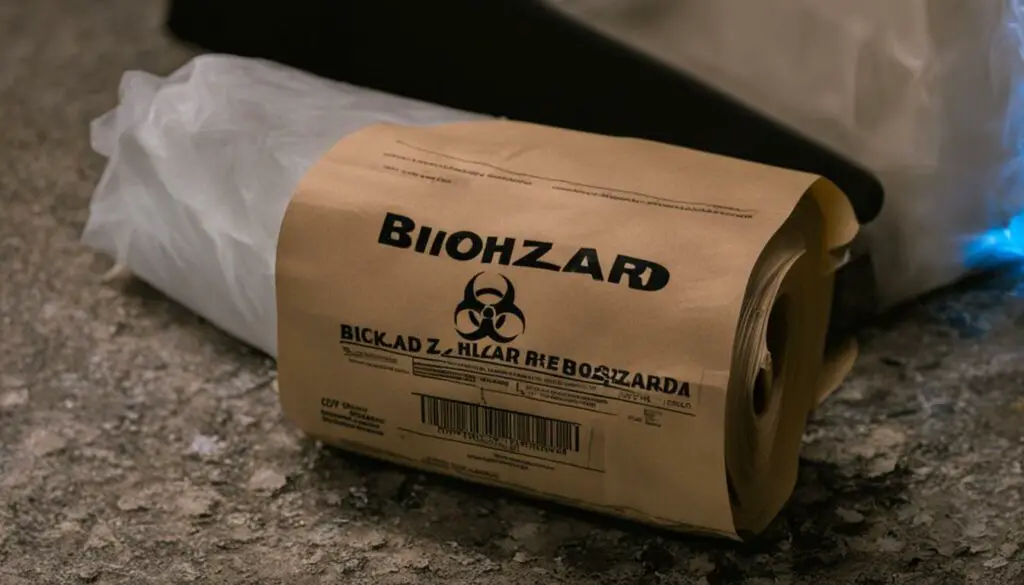
Table: Guidelines for Proper Disposal of Cat Urine Cleaning Materials
| Step | Guidelines |
|---|---|
| 1 | Discard used cleaning cloths, rags, or paper towels in sealed plastic bags. |
| 2 | Dispose of disposable gloves properly to avoid contamination. |
| 3 | Clean tools or equipment used during the cleaning process thoroughly before storing or reusing. |
Following these guidelines will help ensure the proper disposal of cat urine cleaning materials, minimizing the risk of contamination and maintaining a clean and safe environment.
Black Light Maintenance and Safety
When it comes to using a black light to detect cat urine stains, it is essential to take proper care of your black light to ensure its longevity and effectiveness. Regular maintenance of the black light is crucial to keep it in optimal condition and maximize its performance. Here are some important tips for black light maintenance:
- Regularly clean the lens and body of the black light to remove any dirt or debris that may impact the UV output.
- Store the black light in a cool and dry place to prevent damage and prolong its lifespan.
- Ensure that the batteries are replaced or recharged as needed to maintain optimal brightness and functionality.
- Inspect the black light for any signs of damage or malfunction, such as broken bulbs or loose wiring. If any issues are detected, discontinue use and consult the manufacturer or a professional for assistance.
It is also important to prioritize safety when using a black light. While black lights are generally safe to use, it is crucial to follow some basic precautions:
- When using a black light, avoid shining the light directly into your eyes to prevent potential eye damage. If necessary, wear protective eyewear.
- Do not leave the black light unattended when in use.
- Keep the black light away from flammable materials or liquids to prevent accidents.
- Follow the manufacturer’s instructions and guidelines for safe usage.
By taking these maintenance and safety precautions, you can ensure that your black light remains in good working condition and use it effectively and safely to detect and clean cat urine stains.
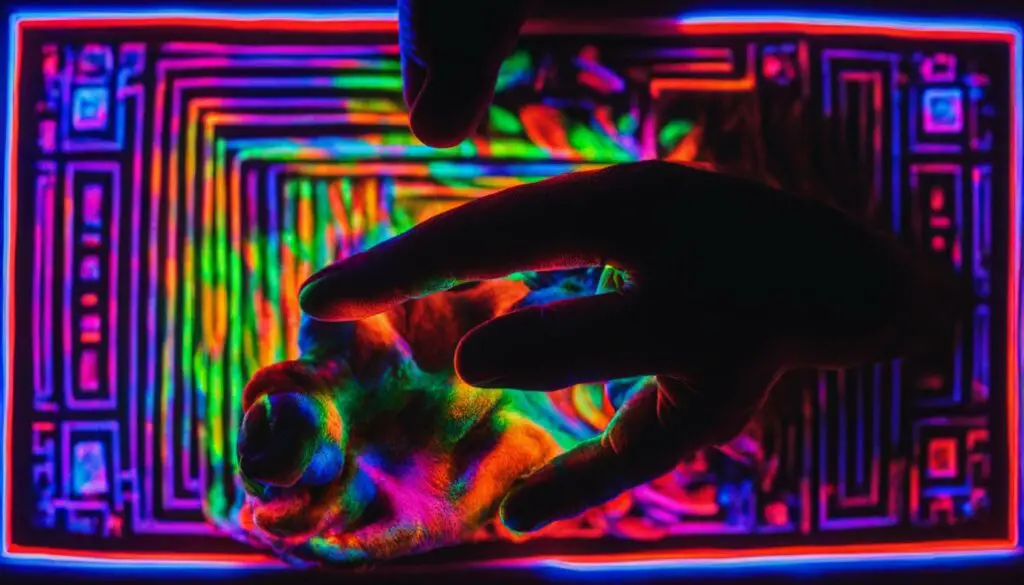
Table: Black Light Maintenance and Safety
| Maintenance Tips | Safety Precautions |
|---|---|
| Regularly clean the lens and body of the black light to remove dirt and debris | Avoid shining the black light directly into your eyes |
| Store the black light in a cool and dry place | Do not leave the black light unattended when in use |
| Replace or recharge batteries as needed | Keep the black light away from flammable materials |
| Inspect for any signs of damage or malfunction | Follow manufacturer’s instructions for safe usage |
The Benefits of Detecting and Cleaning Cat Urine Stains
Detecting and cleaning cat urine stains offers several benefits for both the cat owner and the cat itself. By identifying and addressing urine stains, you can eliminate the odor and prevent the spread of bacteria and other harmful substances. This promotes a healthier environment for both humans and pets. Additionally, regular cleaning of urine stains can help prevent re-soiling and encourage proper litter box use. It also helps maintain the overall cleanliness and hygiene of your home, ensuring a fresh and pleasant living environment.
“Regular cleaning of urine stains not only eliminates the odor but also promotes a healthier and more hygienic environment for both cats and humans.”
Moreover, detecting and cleaning cat urine stains can also have psychological benefits. Cats have a strong sense of smell, and the lingering odor of urine can stress them out or encourage them to engage in inappropriate elimination behaviors. By removing the urine stains and odor, you create a more comfortable and stress-free environment for your feline companion, promoting their overall well-being and happiness.
Furthermore, by promptly detecting and cleaning cat urine stains, you can prevent any long-term damage to your flooring and furniture. Over time, the acidity in cat urine can corrode and stain various surfaces, leading to costly repairs or replacements. By taking proactive measures to clean the stains as soon as possible, you can extend the lifespan of your belongings and save yourself from unnecessary expenses.
| Benefits of Detecting and Cleaning Cat Urine Stains | Importance of Cleaning Cat Urine Stains |
|---|---|
| Eliminates odor and prevents the spread of bacteria | Maintains cleanliness and hygiene in the home |
| Prevents re-soiling and encourages proper litter box use | Creates a healthier environment for both cats and humans |
| Reduces stress and promotes the well-being of cats | Prevents long-term damage to flooring and furniture |
Conclusion
In conclusion, using a black light can be a highly effective method for detecting cat urine stains that are not visible to the naked eye. The UV black light emits wavelengths that cause the proteins and phosphorus in the urine to glow, making the stains easier to identify. By following a proper procedure and taking necessary precautions, you can successfully locate and clean cat urine stains in your home.
Regular cleaning of urine stains not only eliminates the odor, but also promotes a healthier and more hygienic environment for both cats and humans. By removing the urine stains, you can prevent the spread of bacteria and other harmful substances. It also helps maintain the overall cleanliness and hygiene of your home, ensuring a fresh and pleasant living environment.
So, if you are wondering, “Will a black light show cat urine?” the answer is yes. A black light can be a valuable tool in your cleaning arsenal when it comes to dealing with cat urine stains. By investing in a UV black light and following the steps outlined in this article, you can effectively detect and clean cat urine stains, ensuring a clean and odor-free home for you and your furry friends.
FAQ
Will a black light show cat urine effectively?
Yes, a black light can effectively detect cat urine stains that are not visible to the naked eye.
How do I use a black light to find cat urine?
To use a black light for detecting cat urine, ensure the room is dark, use a UV black light with a wavelength of 365-385 nm, and sweep the room starting near the suspected area.
What factors can affect black light detection of cat urine?
Factors such as darkness of the room, the appropriate wavelength range of the black light, dryness of the surface, and the type of surface can affect the effectiveness of black light detection of cat urine.
How do I clean cat urine stains?
To clean cat urine stains, start by soaking up any excess urine, blot the area with warm water and dish soap for fresh stains, or use a vinegar and water mixture for older or dried stains. Rinse and dry the area thoroughly.
What are some other uses for black lights?
Black lights can be used to detect stains from bodily fluids, cleaning products, and certain types of bacteria. They are also used for special effects in photography and creating neon and fluorescent artwork.
How do I choose the right black light?
When choosing a black light, consider the wavelength range, the number of bulbs or LEDs, battery life, and read reviews to find the model that suits your needs and budget.
Are there alternative methods for detecting cat urine?
Yes, some pet owners have had success using DIY black lights made from household materials, although they may not be as powerful or accurate as commercial black lights.
How can I prevent cats from urinating outside the litter box?
To prevent cats from urinating outside the litter box, provide a clean and comfortable litter box, address any underlying issues such as stress or medical problems, and create a cat-friendly environment.
What are the health risks of cat urine?
Cat urine can contain bacteria, viruses, and other microorganisms that can cause respiratory issues, allergies, and infections in humans. Proper precautions should be taken when handling cat urine.
How do I properly dispose of cat urine cleaning materials?
Dispose of used cleaning materials and contaminated items in sealed plastic bags to prevent leakage and odor. Clean tools and equipment thoroughly before storing or reusing them.
How do I maintain and use a black light safely?
Regularly clean the lens and body of the black light, store it in a cool and dry place, and follow safety precautions such as wearing protective eyewear if required. Discontinue use if there are signs of damage or malfunction.
What are the benefits of detecting and cleaning cat urine stains?
Detecting and cleaning cat urine stains eliminates odor, prevents the spread of bacteria, promotes proper litter box use, and maintains a clean and hygienic environment for both humans and cats.

